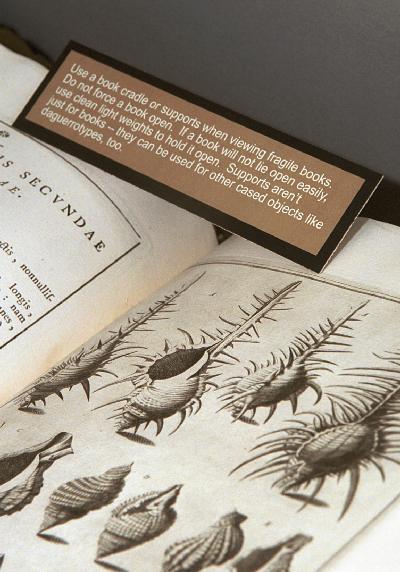October 9, 2003
Preserving paper, new media is subject of Suzzallo exhibit
If you want to prevent your valued documents from becoming brittle and yellow, you might use permanent paper, which isn’t permanent but is likely to last longer than you do.
This is one of the tips on preservation that can be gleaned from an exhibit in 102 Suzzallo through Oct. 31. The exhibit covers the issues the libraries confront in trying to provide access for today’s users, while ensuring that the materials will exist for users in the future. It also gives visitors information to help them preserve their own photographs, letters, recordings, and books.
Permanent paper is able to withstand time and use, and meets the standards that have been set by librarians and others interested in preservation, says assistant preservation librarian Stephanie Lamson, who created the exhibit. It has the proper level of alkalinity, fiber quality and rag content to last well into the next century. But if you’re trying this at home, do not confuse permanent paper with “archival” paper. The use of this term is not controlled and will not assure the paper’s longevity.
The exhibit also examines the growing issue of preserving media in addition to books, including photos, audio and video.
“We usually preserve things in their original format,” Lamson says, “but over time some formats may no longer be available. This is true of video. From 1956 to 1995 at least 50 different video formats were produced. If all we did was to preserve the original, no one would be able to view it. So we have to transfer it to a newer format.”
While it might be desirable to repair or replace items when they begin to show wear or even when they are poorly manufactured, the size of the libraries’ collection, and its budget for preservation, makes that impossible. The circulation desk usually acts as the triage area, where staff decide which items are in critical need for TLC.
“I’ve been wanting to put together an exhibit on preservation for some time,” says Lamson. “I wanted to give people an idea of the breadth of preservation. So much of what is done to preserve materials is invisible to the public.”
While all material will deteriorate over time and with use, the things that some users have done to library materials are just sad. The exhibit contains books that have been burned, covers with wax dripped on them, and volumes nearly destroyed by dogs. The exhibit also deals with planning for disaster — deciding in advance which documents are the highest priority for salvage and recovery.
A related exhibit is located in the Manuscripts and Special Collections area, which describes what those units do to preserve and make these often unusual materials available to the public.



